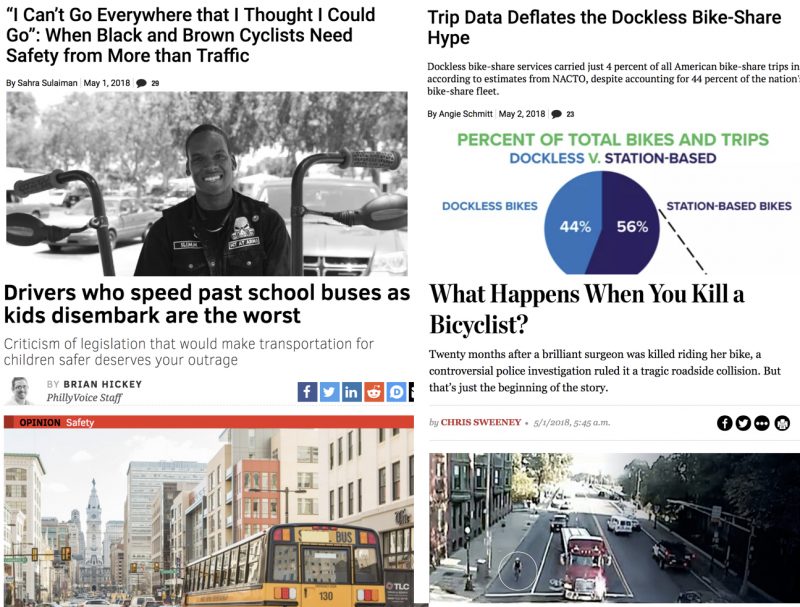
Here are the best stories we came across in the past seven days…
City Council candidate interviews: Still undecided? Don’t miss interviews with the five candidates vying to replace City Commissioner Dan Saltzman by OPB Radio reporter Amelia Templeton.
Must-read interview: Danish architect and city planning consultant Jan Gehl is revered among urbanists and transportation reformers. City Lab nabbed a great interview with him where he touches on the corporate-fueled technology dream (he’s unimpressed) and how we should count people like traffic engineers count cars.
No justice: A necessary dive into the sad case of Anita Kurmann in Boston, where the systemic bias against bicycle users and victim-blaming within law enforcement agencies is laid bare.
Justice: The Michigan man who purposely drove his car into a group of riders in Michigan was found guilty on for counts of murder.
Motorized bikes FTW: Seattle is just the latest city to get all giddy about the potential of electrified bicycles.
The right to drive dangerously: The Philly Voice provides this week’s takedown of the National Motorists Association, a pro-car group with an army of emailers defending the rights of drivers nationwide.
Advertisement
Bike share data: Don’t miss this deep-dive compilation of bike share statistics published by NACTO. One surprising tidbit: dockless bikes made up a whopping 44 percent of the total bikes available, but just 4 percent of the total trips, leading Streetsblog to wonder if that deflates the dockless hype.
Contested streets in LA: A fascinating look at the intersection between the personal struggle for safe mobility on public streets and the gangs who control it.
Not their fault: Another example that you simply cannot proclaim to care about equity unless you aggressively battle climate change.
How to tame your white privilege: This post on Colorlines from a community organizer from the Tohono O’odham Nation, features solid advice about how to check your privilege and work with people who don’t look like you. It’s very applicable to the transportation advocacy world here in Portland.
Trees are lit: I like to think bicycle riders are the most powerful force in creating great cities, but this article has me thinking trees might be the real winners.
New book alert: The Gospel of Donald Shoup has been updated. I repeat, the God of Parking Reform has published a new book!
Londoners are over cars: Since their mayor said she’d consider it, thousands of London residents have signed a petition saying they want a carfree day this fall.
— Jonathan Maus: (503) 706-8804, @jonathan_maus on Twitter and jonathan@bikeportland.org
Never miss a story. Sign-up for the daily BP Headlines email.
BikePortland needs your support.



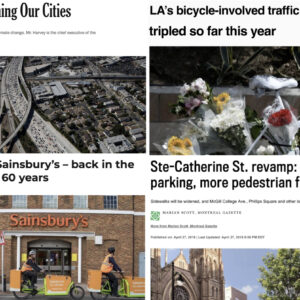
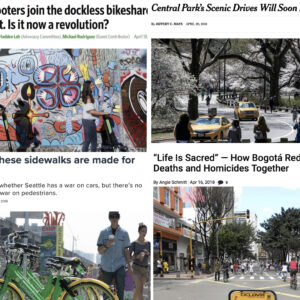
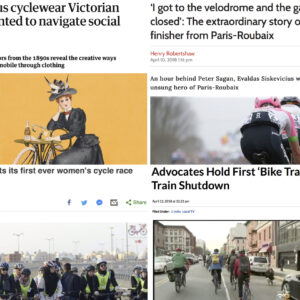
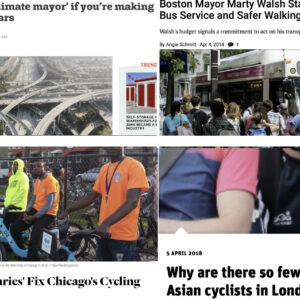
Thanks for reading.
BikePortland has served this community with independent community journalism since 2005. We rely on subscriptions from readers like you to survive. Your financial support is vital in keeping this valuable resource alive and well.
Please subscribe today to strengthen and expand our work.
My favorite part from Jan Gehl’s interview, ” I think we haven’t thought through the challenge of technology for city mobility. We are stuck with some 120-year-old ideas that the industry is desperately holding on to.”
Its time to cut loose the auto and petroleum industry from their self appointed role as master planner of our living space. Lets send them to the same dustbin of history as those who promoted the idea that the sun revolved around the earth.
My favorite part was: “I have been extremely impressed by what they’ve done in Moscow. In just five years they’ve cleaned up the city, got their parking organized, and introduced wider pavements and bike lanes and a city bike system. They have been very focused on making a much more livable city for pedestrians and bicyclists, and they have done miracles in a very short time.”
I was in Moscow last year and rode bikes while I was there. On the positive side, there is some dedicated bike infrastructure as well as rental bikes. It’s a great way move through touristy areas in the very center. Moscow has always been a very friendly city to pedestrians as hardly anyone had access to cars until more recently. I’ve spent quite a bit of time there since the Soviet days (was actually there for the collapse as well as the coup when they blasted their own White House with tanks). I personally think the city has gotten less friendly to peds over time.
I see zero potential for Moscow to become a cycling city. Things are too spread out for most people, traffic is very fast and drivers are gonzo, it’s not a good cultural fit, and there’s absolutely no comparison between weather in Moscow and Portland where what passes for a storm is amusing to anyone who’s not from here or California.
On the flip side, public transit is awesome. Metro moves 60mph and runs every minute on many lines even at night https://www.youtube.com/watch?v=Xj_b5R60r1s Also, there’s practically no parking because when the Moscow was planned and the lion’s share of living space and roads were constructed, it was specifically assumed that people would take public transit.
All the same, despite the awesome and safe public transit which runs until 1am, hopeless parking situation, and high costs associated with motor vehicles, most people will take a car if they can.
Actually, really. About 20% of the America public believes the earth is flat and the sun revolves around it. And these are the guys in charge!
“dockless trips made up a whopping 44 percent of the total bike share trips, but 4 percent of the total”
I think there was an editing error here, I’m not sure what the takeaway is supposed to be.
Yes. Editing error. Sorry for the confusion. Sentence corrected to: “… dockless bikes made up a whopping 44 percent of the total bikes available, but just 4 percent of the total trips…”
Speaking of 4, should be “four counts of murder” in Kalamazoo.
I stand corrected. Of course, if he wasn’t DUI…
Streetsblog:
“Dockless bike-share carried just 4 percent of all bike-share trips in 2017, according to NACTO’s estimates, despite accounting for 44 percent of all shared bikes. On a per-bike basis, station-based systems yielded an average of 1.7 rides per day, compared to 0.3 rides per day for dockless systems.”
“a business model that relies on cheap equipment and low maintenance costs”
“It’s possible to provide dockless systems that also have well-built equipment, reliable maintenance, and operations that don’t skimp on rebalancing — and maybe systems like that will get more use. We just haven’t seen one yet, at least not at scale.”
BikeTown will be the quality non profit dockless system. If we have a little patience. Letting for profit companies dump 10,000 bikes in Portland, put BikeTown and others out of business, then leave the surviving company with a for profit monopoly, is a bad idea.
Has anyone found the University of Washington data on Seattle’s bikeshare pilot?
The NACTO authors apparently interviewed the UW researchers and obtained some ride/bike/day data and time of day/week data. I’d be interested in seeing more detailed and geographical data as well.
If dockless isn’t producing any rides, why should anyone, including Biketown, be worried about it? Why the paranoia? Mind you, we have 2017 numbers for bikes but only 2016 data for rides, so the data from those 2017 bikes isn’t even available, so we must rely on Nacto estimates, which might as well be figures picked out of the air. Garbage in = Garbage out.
Because 5,000 for profit dockless bikes dumped into Portland might soak up 1,500 rides/day (0.3 ride/bike/day). Many of those rides will be taken away from BikeTown. BikeTown is not funded by $1 billion in Chinese investors’ capital; it has a fixed amount of sponsor dollars to fund operations. It won’t be able to stay in business with for profit dockless bikes soaking up the rides. With BikeTown out of the way, and small players like LimeBike bankrupt, the biggest for profit company with the deepest pockets will own Portland’s bikeshare market.
Your statement “dockless isn’t producing any rides” is an incorrect way to put it. The accurate statement is that dockless is producing very few rides compared to the number of dockless bikes. But $100MM or $1BN of investor capital to burn will pay for a heck of a lot of bikes, for a little while.
I don’t for one second buy the idea that “dockless isn’t producing as many rides”.
My experience in Seattle – back in rainy January – was seeing people on sharebikes everywhere. My own anecdotal observation was that Seattle had at least as much density of people actually riding sharebikes on the street as Portland – and over a larger geographic area. I’m wondering if the math is being done right.
Also, Seattle has about 10x as many sharebikes on the street as Portland, so even if Seattle had only as many riders as Portland (and I suspect it has more), you’d expect docked bikeshare in Portland to be generating 10x as many trips per bike as dockless in Seattle. But so what?
“I’m wondering if the math is being done right”
I imagine the U of W researchers can do math.
I’ve estimated ride/bike/day from the limited data placed online by SBOT and come up w/ similar results.
tend to be used more by visitors and tourists.
The Michigan man who purposely drove his car into a group of riders in Michigan was found guilty on FOUR counts of murder.
Or was it five? He got nailed on all 14 counts against him.
It will be interesting to see if he faces any significant jail time.
K’Tesh, was your point that there is a typo error? Spelling “for” instead of “four”?
“unless you aggressively battle climate change.”
considering that we are emitting more greenhouse gases than we ever have i have to wonder who this “you” is.
“We have met the enemy and them are us.” – Walt Kelly (Pogo)
Regarding the trucker that killed the cyclist in Boston, why do we, as a matter of policy, permit vehicles that are demonstrably unsafe for city driving drive around our cities?
You mean not allow trucks in cities? Yeah, that’ll work…
Ignoring that if you put a lot of people in a tiny area, you need some way of getting them things they literally need to live, many things (equipment, building supplies, fire truck ladders, etc) are of a size that actually requires a truck. And, even if you wanted to move everything that could be moved using much smaller vehicles, it would lead to an enormous increase in traffic which might not even reduce hooks or improve safety.
There are things that can be done to make the roads safer and reduce presence of large vehicles on smaller roads. But modern life requires large vehicles for some tasks. I would observe that the buses everyone likes so much here are arguably oversized and I have more trouble with them encroaching in bike lanes and on me when I’m not in bike lanes than any other vehicle type.
It doesn’t have to mean ALL trucks, nor a total ban on the largest ones.
I would only consider restricting the operations of vehicles which are particularly dangerous; larger trucks that “sweep” adjacent lanes when they turn, where operators cannot see people they might crush. There are numerous solutions to this problem: better sensors to ensure adjacent lanes are vacant before turning; trucks with a second driver in the rear (such as the design larger firetrucks use); different truck designs where the trailer better tracked the cab (similar to an articulated bus); routing that avoided right-turns across vehicle/bike lanes; special signaling to alert people in the danger zone; smaller satellite trucks for urban deliveries; etc.
There is nothing radical about asking for vehicles to be designed to able to safely operate in the environments in which they’re driven. It seems far more extreme to suggest they need not be.
Yes, and there’s even simpler control that can happen.
Example–the Sellwood Bridge project used the Willamette Greenway Trail as a turnaround location for hundreds of truck trips–that meant dump trucks backing up blindly into the paths of people walking and on bikes, who had to squeeze around them without much clearance. If they’d driven only a couple blocks further, they could have turned around in the huge, mostly-empty Willamette Park boat launch parking lot. This was a situation where the County and contractor had the ability to have total control over where the trucks turned around, but didn’t take control.
Large trucks are often working for companies or government entities who could exercise much more safety-related control than they do over routes, loading areas, etc.
I still meet occasional traffic engineers, usually older white males from state DOTs, who sincerely believe that pedestrians and bicyclists are only asking for trouble, that we as a society would be better off and safer if we all got around entirely by car.
All the Boston cases, as here and in Portland, prove that if you want to get away with murder, hit your victim with a car or truck and “make it look like an accident”, as the mafiosi would say.
There is certainly truth in that, though I find the demographics holding that view considerably more expansive, and certainly reflecting better gender and racial equity.
One thing that does not help those attitudes is the insistence by the most vocal of those who identify themselves as cycling advocates (a group dominated by white males) not only justify but encourage ignoring basic practices expected of all road users. For example, intentionally positioning yourself to the right of a turning truck is incredibly dangerous even with a steel safety cage around you. I’ve never been in a car where the driver did this, but I see cyclists doing this frequently. Same can be said for being on roads at night without making any effort to be visible.
i also find it very disturbing that portland cyclists use bike lanes. do they not realize how dangerous these facilities are? and why do they not follow the good example of car drivers? i just don’t get it.
until cyclists take personal responsibility for driving their bicycles, it’s our solemn obligation to chastise them on bike portland as often as we can.
Passing on the right of turning vehicles is inherently dangerous for a number of reasons. This is why states that mandate that vehicles do not enter bicycle lanes when turning right are outliers.
Here in Portland, we like to pretend we’re special and that reality affects us differently. So we insist that goofball practices that are virtually unheard of elsewhere such as having plows “skim” when it snows and not fluoridating water is based on superior insight while it makes us the butt of jokes nationwide. There’s a reason Portlandia resonates with as wide an audience as it does.
Passing on the right prioritizes convenience over safety. Though I’m not sure it even does that because I can’t tell you how many times I’ve seen cyclists get hooked or boxed (most recently multiple times this morning on Broadway) while I got by much smoother/faster simply by passing on the left.
If you ride with the assumption that all drivers are engaged, competent, and will see you coming up from behind on the right in their mirrors while they watch for peds in front and threats from the left, you’ll be disappointed frequently. But I’m sure enough complaining in venues none of them read or care about will help.
why do you keep saying (or implying) that she was passing the truck driver? The story says he had passed her, was legally required to track her because he had just passed her.
It doesn’t matter. The truck is dangerous no matter who is passing whom, because it makes turns from a central lane, across another travel lane. Whether the driver is at fault in this particular instance, while greatly important to the principals, is not relevant to the question of how we can make this sort of interaction safer.
“Whether the driver is at fault in this particular instance[…] is not relevant ….to the question of how we can make this sort of interaction safer.”
I’ve never understood the urge to shift the conversation from fault to road design. Why can’t we keep both in focus? Fault is super important and I think always worth assigning. If the powers that be find driver inattention, cyclist position, and road design all partially at fault, ok; let’s apportion fault, but not abandon efforts to assign it.
Turning across the lane to the right is inherently dangerous.
Yes, fault is important. Just not to us, here in Portland. I’m saying let’s focus on what does matter, to us, which is how to prevent this from happening here (is again). I don’t blame road design, in this case, but vehicle design. Whether the driver didn’t look, or the cyclist approached during the turn doesn’t change the fact that the vehicle itself is quite dangerous because it turns from a middle lane, and can crush people who are stopped beside it, and may appear to be out of harm’s way.
Tamar Monhait, Brett Jarolimek, Tracy Sparling
Driver error; preventable; fault.
Which isn’t to say that truck design or size, or road design aren’t also factors.
Mark Angeles.
If we just say “driver’s fault”, that gets us off the hook. We have someone to blame, and we can get on with our usual arguments. This is a case where we need to look beyond that.
Kathryn Rickson
Ethan Wong
http://elestoque.org/46006/news/about-a-year-ago-ronald-wong-lost-his-son-ethan-wong-to-an-unforgettable-bike-accident/
It’s also common to meet police officers who share the belief that pedestrians and cyclists are a nuisance distracting them from the business of dealing with people in cars.
How about just enforcing laws governing their behavior? Make it expensive enough to get drivers’ and their employers’ attention. Most trucks don’t kill people, but you do get the odd driver who acts like they were recruited out of the monkey house at the Washington Park Zoo.
The problem is that it isn’t careless truck drivers that are the problem, as far as I can see, but vehicles that are inherently unsafe in the environment in which they are operated. True, cyclists may at times put themselves in a dangerous position, but part of that is because we don’t normally see vehicles turning right from the center lane, and essentially moving “sideways” into the rightmost lane where we might have pulled up, not realizing the truck was turning.
as sad as it is it’s just more reason to take the lane… don’t be pushed to the fringes where the laws aren’t clear… stay in the lane where you have a right to be…
And where you often need to be.
I frequently (some or all of the time on practically every section of road) find it necessary to take the lane even when a bike lane is provided. The laws might clearly state that you need to ride as far right as practical, but I have never even been questioned by the cops. Have only been admonished a few times by motorists who backed off when I explained why I was out there.
One can be assertive, take the lane, and still be courteous.
It’s called riding where drivers are actually looking.
HK,
Couldn’t the same be said for bikes?
Is it the vehicle, or the vehicle operator that is unsafe?
>>> Is it the vehicle, or the vehicle operator that is unsafe? <<<
Yes.
Fundamentally, large trucks behave differently than any other class of vehicle. It is inherent in their design. If a vehicle can't make a right turn from the right lane, and threatens to crush (and whose operator can't see) anyone who approaches in that apparently vacant right lane, is it really safe to be driving it around in a crowded urban environment?
None but the largest and most mighty and fearsome of bicycles pose the same threat.
Oh hey, Jonathan.
London’s mayor is a man, Sadiq Khan.
Interesting photo of the truck driver right-hooking the cyclist he killed in Boston… note the sharrows where his right front is. Some might contend she’d still be alive today if she was positioned where the sharrows recommended.
The intersection looks very different today: https://goo.gl/maps/5fUxMjH9fp42. The bike lane has a small buffer, placing the cyclist even closer to the curb than the former sharrows did. And there are bike boxes for box lefts – now that’s a rarity! That design here in California would have turned out quite different – there’d be 100′ of dotted gore line and the bike lane would be shared as a right-turn lane with cars (i.e. it’d be a fustercluck…).
I’d say their “improvements” are a real flustercluck what with the door-zone bike lanes. At least MA isn’t a mandatory use state.
Aye, there’s the rub. For a segment of the (cycling) population, the sharrows signaled to drivers the cyclist’s right to position there (though we know it’s usually implied by law), and telegraph to the (not-so-timid) cyclist to take the lane for the intersection duration to avoid this exact scenario.
But alas, that neither works for the entirety of the (cycling) population, nor does it work if the majority of drivers and cyclists are not trained in either the techniques or the markings.
If I were to ride through this intersection now (which I’m familiar with from college days), the extent to which I’d be positioned into the travel lane would depend on 1) traffic density / gaps, 2) my speed, and 3) the light (red/yellow/stale green). Chances are high that I wouldn’t be in that marked bike lane, and drivers possibly thinking, “Why the hell isn’t he riding in the bike lane where he belongs?”.
Total crickets on the “white privilege”. Interesting. There is more work to be done.
And what would you like us white males to say about that one? The article doesn’t have anything directly related to cycling… Here is what I would add: “I agree, those sound like good things! Who knew being a decent human being was so hard for some people?”
Sometimes crickets is the best response from those of us in the majority.
Had to read it, given the attention drawn. Only thing I took away was that several behaviors she indicated were “racist” were more what I would call ignorance, but then again, I may just be “unknowingly racist.”
My reaction was to think that while I don’t see the connection to cycling, Cazares-Kelly describes some pretty insensitive people.
Why so glib?
To my knowledge no European city allows semi trucks to plow around the inner cities.
There are plenty of big trucks “plowing around” the center of Stuttgart, to pick one of many examples.
OK, but are they routinely crushing folks not in cars while turning? My guess (which we’ve seen sometimes isn’t worth much) would be no.
They’re not “routinely” doing so anywhere I am aware of.
I too have seen them making deliveries in many European cities, especially in France, Belgium, and Germany. I have also been to several cities in those same countries, often in those same cities, that make a big point of banning the larger trucks and semis from inner parts of cities where streets are too narrow and too busy with pedestrians. For deliveries, the shipping companies transfer larger loads from semis into smaller local delivery vehicles, with most deliveries made in the early morning or late evening.
And trucks often swing wide, effectively turning across a lane to the right, whether or not there is a bike lane.
Even if cars were to pull into the bike lane to turn, as required in California (and Minnesota where I live*), 52′ trucks are still going to turn from a travel lane.
* having lived with it for three years now, I hate hate HATE this law. It is NOT safer to have cars weaving with bikes in the bike lane. Too often turning traffic clogs up the bike lane, forcing cyclists to choose between stopping and waiting, or moving around to the left into the general lane with cars that are going straight at much higher speeds than the cars that are turning. Maybe a few S&F types prefer passing on the left, but I sure as hell don’t. I would MUCH rather monitor the right-hook danger from cars on my left, something I got pretty good at after nearly two decades in Portland.
Even if you don’t have a bike lane, on any type of road motor vehicles are going to pass slower bicycles on the left. And when they make right turns, they are going to cross the paths of cyclists. Getting rid of bike lanes, as some VCers propose, or adopting the dumb California law, will not substantially improve our safety. There is no magic sword to slay the right hook, but the danger can be mitigated, however, with enforcement, awareness, light timing (possibly combined with full mode separation), and modifying or restricting large trucks.
Speaking of trees, come on the Epic Street Tree Ride:
http://www.orangesplot.net/ride/